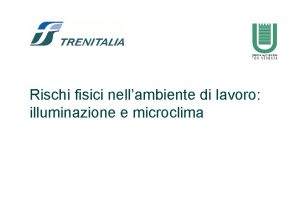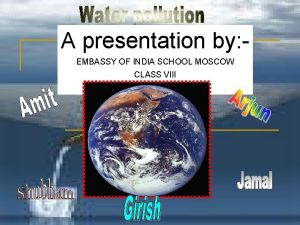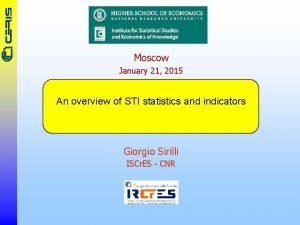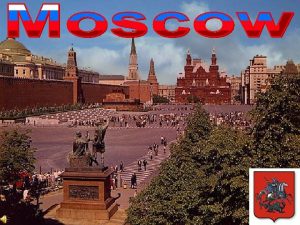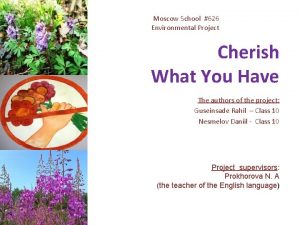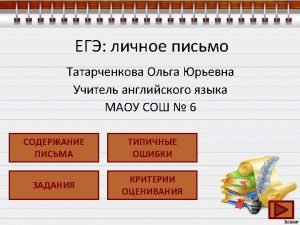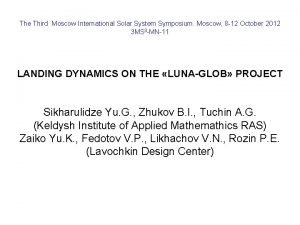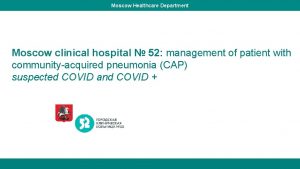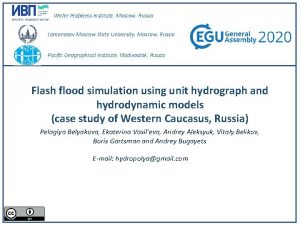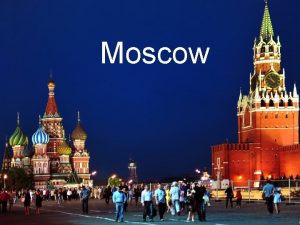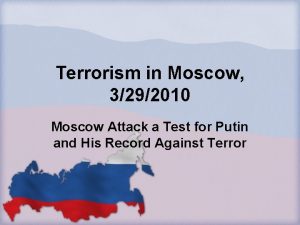Moscow School 626 Cherish What You Have The





















- Slides: 21

Moscow School #626 Cherish What You Have The authors of the project: Veshkitov Jozef – Class 10 Guseinsade Rahil – Class 10 Nesmelov Daniil - Class 10 Tantsura Ekaterina – Class 10 Zelenin Sergey – Class 9 Project supervisors: Konoplyova E. A (the teacher of Biology and Ecology) Prokhorova N. A (the teacher of the English language)

Relevance In 1991 the Kotlovka river valley was declared a natural monument The floodplain of the Kotlovka river is included in the boundaries of the landscape reserve called "The valley of the river Kotlovka". Now the question is about giving it the status of especially protected natural territories of regional value.

Project Objectives • 1. Studying plant species and diversity of plant communities represented in the national park "The Valley of the river Kotlovka". • • 2. Identifying rare species of plants. 3. Attracting public attention to the need of preserving this area. 4. Creating handout for school lessons of Biology, Ecology, Geography and English while studying themes "Plant communities" , "Species diversity of plants", "Ecological issues of the native area and ways of coping with them”

Brief Description of the Study Area The floodplain of the river Kotlovka - 1, 8 km between Nakhimovsky Prospekt and Remizov street. It is the third largest tributary of the right river bank of the Moscow river. The river is full of rapids with very fast current. The river is rocky, rarely sandy or muddy. It’s full length is 9, 5 km. Its valley is deeply incised and picturesque; in the form of a narrow strip, there remained several sections of riverine woody vegetation, meadows and floodplain marshes. garages Furniture factory The Korobkovsky Orchard Founded in 1880 the garden is famous for rare grades of fruit trees and berry bushes. Later on it was transformed into a nurserygarden where some scientific breeding work was deployed. In 1980 -s the nursery garden was joined to Butovo state farm. Since 2008 the territory is closed for visiting. Gas Station Nahimovsky prospect

The Results of the Study In the floodplain of the river Kotlovka the following plant communities were described : willows (1), forest vegetation (2), floodplain swamp (6), riparian woody vegetation (3, 4, 7) and meadows (5).

Floodplain Swamp • The rich soil and abundance of moisture promotes the growth of moisture-loving vegetation. Among the trees the most common is black alder. • The following plants are frequently met: horsetail marsh, common reed, broadleaf cattail, cane forest, sedge early and sedge bubble. • In the southern part of the park from the left side there can be found The Western marsh orchid and it was noted a single plant of the Calla marsh. •

Riparian woody vegetation • Woody layer forms a shading. It is represented by alder, birch and aspen (No. 34). Small trees are mountain ash , bird cherry and common buckthorn shrub brittle. The main herbs are wild ginger, the male fern, horsetail, and sedges. • The composition of the ground vegetation consists of light-loving herbs such as plantain, dandelion, sorrel, wild strawberries, violet, primrose spring, lesser celandine, lily of the valley. In damp places there can be found Lychnis flos-cuculi, commonly called (family Caryophyllaceae).

Willows • The willows (#1) have a single tier stand. Under its canopy there develops the vegetation of hygrophilous grasses – sedges, reeds, nettles. • Along the river bank there grow parsley family herbs such as goutweed, copyri forest; as well as Impatiens noli-tangere (touch-menot) and Rubiaceae – bedstraw Northern.

Forest Vegetation • The oak dominates. (see number 2 on the map). The composition of shrubs consists of common hazel, euonymus warty, black alder. • In the herbaceous layer there can be found fern male fern, horsetail, goutweed ordinary, sedge hairy, European wild ginger and Solomon's seal. • From April to early June there blossom spring ephemeroids such as fumewort, lesser celandine, yellow anemone , yellow star- of-bethlehem , unspotted lungwort, víola mirábilis – wonder violet

Meadows • Meadows occupy a gentle left slope of the river • Kotlovka (see # 5). Steep areas are overgrown with blackberries. The gentle slope adjacent to • the park Sosenky is exposed to mowing. • .

Meadows gramineae or grasses Timothy-grass, fescue, brome, quack grass, cocksfoot bean family a hybrid clover, white clover, vetch, rank grassland asteraceae other herbs greater burdock, dandelion, tansy, chicory, cornflower meadow, yarrow geranium meadow, Ivantea, cuff, silvery cinquefoil, sorrel, plantain and plantain meadow

Early Blossoming Plants Anemonoides ranunculoides It was discovered: 4 ephemeroids species - The Yellow anemone, The Fumewort, The Lesser celandine, The Yellow Star-of-Bethlehem ; 3 rare species - The Cowslip, The Unspotted lungwort, The Heath dog-violet ; 2 ephemeroids species - The Western marsh orchid, The Eearly marsh-orchid (2 -3 Red List category) Corydalis solids Gágea lútea Ranunculus ficaria Primula veris Pulmonaria obscura Víola canína Ásarum europaéum Dactylorhiza incarnata Dactylorhiza baltica Polygonatum multiflorum

The Research Methods Routing method: the research way on detection of early spring blossoming plants. IUCN Red List Categories Group divisions according to Russia their frequency of occurrence: Red List found frequently and Categories abundantly, found moderately and found seldom

The Status of Conservation Red List of Threatened Species Critically endangered (CR) – Extremely high risk of extinction in the wild. Endangered (EN) – High risk of extinction in the wild. Vulnerable (VU) – High risk of endangerment in the wild. Near threatened (NT) – Likely to become endangered in the near future. Least concern (LC) – Lowest risk. Does not qualify for a more at-risk

Species of plants in Frequency Life form Latin, English, Russian Anemone ranunculoides The Yellow anemone Ветреница лютичная Dactylorhiza majalis The Western marsh orchid Пальчатокоренник Балтийский IUCN Red Russia Red of List occurrence Categories Moderately geophytes frequently rarely geophytes Places of occurrence The slopes of the Near Korobkovsky ravine threatened along the garden boundary, right bank (NT) 3 The valley bog in the Endangered 2 southern part (EN)

Species of plants in Latin, English, Frequency of Russian occurrence Anemone ranunculoides The Yellow anemone Ветреница лютичная Corydalis solida The Fumewort Хохлатка плотная Pulmonaria obscura The Unspotted lungwort Медуница неясная Primula veris The Cowslip Первоцвет весенний Ficaria verna The Lesser celandine Чистяк весенний Gagea lutea The Yellow Starof-Bethlehem Гусиный лук Viola canina The Heath dog-violet Moderately Life form geophytes frequently Moderately geophytes frequently rarely hemicryptophyte Places of occurrence The slopes of the Korobkovsky ravine along the garden boundary, right bank IUCN Red List Russia Red List Categories Near threatened 3 (NT) Along the garden boundary, right Near threatened bank (NT) Larch plot in southern part Near threatened 3 3 (NT) rarely Moderately hemicryptophyte geophytes frequently single geophytes Фиалка собачья Asarum europaeum Moderately The European wild ginger frequently Near threatened southern part (NT) 3 The slopes of the Korobkovsky ravine Least concern (LC) along the garden boundary frequently Moderately The slope over the collector in hemicryptophyte The slopes of the Korobkovsky Least ravine along the garden boundary concern (LC) The slope over the collector in Least southern part concern (LC) The valley bog in the southern Endangered (EN) 2 Near threatened 3 Копытень европейский Dactylorhiza majalis rarely geophytes The Western marsh orchid part Пальчатокоренник балтийский Dactylorhiza incarnate The Eearly marsh-orchid rarely geophytes The valley bog in the southern part (NT)

Conclusions It is necessary: • to plan and improve the major routes and places of recreation in combination with visual ecological information; • to make information stands "Plants and animals listed in the Red book of Moscow“ with the indication of the subject matter encountered in the area; • to draw public attention to the problem of the park "the Valley of the river Kotlovka“ providing them with posters and videos on social networks; • to plant trees along the borders of the park.

The Stages of the Project Work • Search stage. Subject definition, problem analysis, goalsetting of the project. May-June 2016 – field research. • Analytical stage. Analysis of the available information, the search of the information gaps, the construction algorithm activities. September-October 2016 – distribution of work between team members. Analysis of the resources. • Practical stage. The implementation of the planned activities and changes. November – December 2016. • Presentation stage. Preparation of presentation materials. Exploring the use of project results. January – February 2017. • Control stage. The analysis of the implementation of the projects. Quality assessment. March-April 2017.

• Performing and lecturing in front of 6 -7 formers. • Posters “The Year of Ecology”

• Posters on the school walls «The Valley of the River Kotlovka” and « 2017 – The Year of Ecology in Russia”

 We should appreciate cherish and cultivate blessings
We should appreciate cherish and cultivate blessings Drinkmoment
Drinkmoment Form ssa-1694
Form ssa-1694 Cs 626
Cs 626 Ab 626 san bernardino county
Ab 626 san bernardino county Verticall
Verticall Because you have rejected me i have rejected you
Because you have rejected me i have rejected you Embassy of india school moscow
Embassy of india school moscow It has six faces 12 edges and 8 vertices
It has six faces 12 edges and 8 vertices Tokyo climograph
Tokyo climograph My friends lives in moscow said alec
My friends lives in moscow said alec Confucius institute at moscow state linguistic university
Confucius institute at moscow state linguistic university Moscow state regional university
Moscow state regional university 1147 moscow
1147 moscow Sti university moscow
Sti university moscow Moscow is the capital of which country
Moscow is the capital of which country Moscow is the capital of russia our motherland
Moscow is the capital of russia our motherland Ros business consulting
Ros business consulting Luke upchurch
Luke upchurch Grasslands climograph
Grasslands climograph 127287
127287 Moscow state university of design and technology
Moscow state university of design and technology





